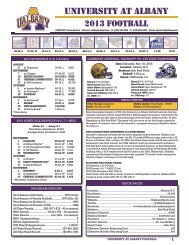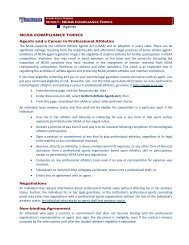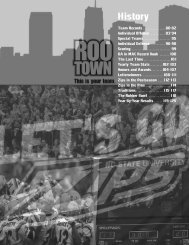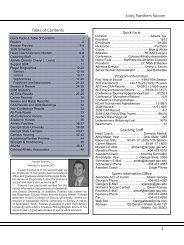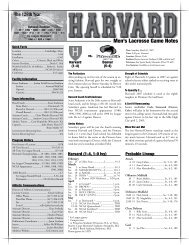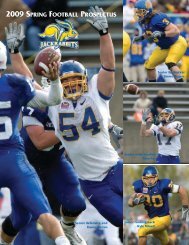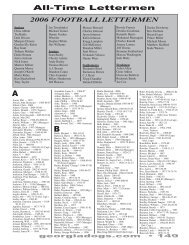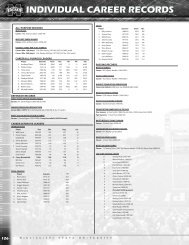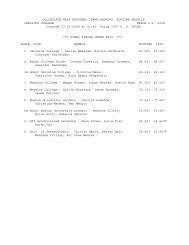Wrestling layout 04-05 - Home Page Content Goes Here
Wrestling layout 04-05 - Home Page Content Goes Here
Wrestling layout 04-05 - Home Page Content Goes Here
You also want an ePaper? Increase the reach of your titles
YUMPU automatically turns print PDFs into web optimized ePapers that Google loves.
steadfast). In 1988 one of the two lions on the seal was officially<br />
replaced with a lioness. The seal is now the focal point of the “Hofstra<br />
Pride” logo.<br />
34<br />
THE HOFSTRA NICKNAMES<br />
The Hofstra nickname has also evolved over the years. For decades,<br />
Hofstra athletic teams have used the nicknames Flying Dutchmen,<br />
Dutchmen, or Dutch. Recently, an additional nickname of The Pride has<br />
become popular. We have not changed our nickname. We are both the<br />
Dutch (and its variations) and the Pride.<br />
The Pride nickname started during the University’s dramatic recovery<br />
and growth in the mid to late ‘80’s from a major fiscal crisis during the<br />
previous decade. The first consistent use of the word “Pride” relating to<br />
athletics started in 1989 when the University’s athletic booster club was<br />
founded and called itself The Pride Club. At that time it had no meaning<br />
associated with our teams. It was simply consistent with a general<br />
feeling about all of our efforts.<br />
The Pride nickname has also evolved over the past decade in a more<br />
specific fashion than just the expression of the feeling. The word pride<br />
is used to describe a sense of having strong self-respect or a sense of<br />
accomplishment. But in 1988 the lion on the right side of the shield on<br />
the Hofstra seal was changed into a lioness to symbolize gender equity.<br />
This, in turn, led to the development of the University mascots — Kate<br />
and Willie Pride, a lion and lioness. The two lions led to extensive use<br />
of the word “Pride” in talking about Hofstra, as a group of lions is called<br />
a pride. In 1995 bronze reproductions of the<br />
lion and lioness were added to the campus<br />
scenery. In fact, there are now four such<br />
pairs of sculptures on campus.<br />
However, the evolution continues even<br />
further. In 1997, the University purchased a<br />
sculpture by Paul Manship of “Atalanta,” a<br />
figure from Greek mythology. It is an<br />
impressive 14-foot tall figure of a running<br />
woman. It is on the west side of Hofstra<br />
Stadium. To complement this figure, in<br />
1998, the University commissioned Gregg<br />
Wyatt to sculpt a similarly sized figure of a<br />
running man. In this case it was a<br />
representation of “Hippomenes” who was a<br />
central figure in the myth. The myth of<br />
Atalanta and Hippomenes relates closely to<br />
Hofstra symbology.<br />
As the myth goes, an Oracle told Atalanta,<br />
as a young girl, that she must never marry.<br />
Thus, Atalanta avoided men and devoted<br />
herself to the chase. Soon she could outrun<br />
any man. Yet because Atalanta was so attractive she had many suitors.<br />
To deal with them she imposed an almost impossible condition. She<br />
HOFSTRA HERITAGE<br />
would only marry one who could beat her in a foot race. While she<br />
would be the prize of such a race, the penalty for losing was death.<br />
Nonetheless there were suitors and there was need of a judge for such<br />
races. Hippomenes was chosen for this role. However, when he saw<br />
Atalanta he immediately fell in love with her. Knowing he could never out<br />
run her, he sought the help of Venus.<br />
Venus agreed, and gave him three golden apples, which Hippomenes<br />
was to throw in front of Atalanta during the race. The apples were so<br />
desirable it would be impossible for her to resist picking them up, and<br />
thus she would lose the race. All this came to pass, and when the race<br />
was over and won by Hippomenes, they fell deeply in love and the youth<br />
carried off his prize. However, they angered Venus for their failure to<br />
thank her. As punishment, she turned Hippomenes into a lion and<br />
Atalanta into a lioness.<br />
With this strong identification with lions and the multiple meanings of<br />
the word pride, our coaches and players, as well as the sports media,<br />
have begun to use it extensively over the last several years. Our<br />
women’s teams especially are more comfortable calling themselves The<br />
Pride, which is genderless, than they are calling themselves The Flying<br />
Dutchwomen or the Lady Dutch. The men’s teams are also comfortable<br />
with the nickname Pride.<br />
However, as noted earlier, we have not abandoned the Flying Dutchmen<br />
or formally adopted The Pride. There is nothing wrong with having more<br />
than one nickname. It is not uncommon for a school to have two<br />
nicknames as institutions such as Yale, Virginia, Georgia Tech and Army<br />
have multiple monikers. The bottom line is our name is HOFSTRA.<br />
OFSTRA PRIDE WRESTLING



